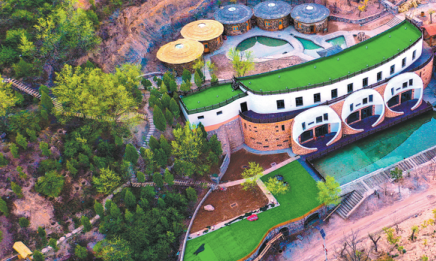Wellness trips growing into a promising sector
Updated: 2023-04-21

A wellness resort in Taiyuan's Yingze district. [Photo provided to China Daily]
Shanxi is using its advantages such as pleasant climate, convenient transportation options, enjoyable food offerings and rich cultural and natural resources to boost the development of its wellness tourism industry.
Wellness tourism is an emerging sector in the wider picture of traveling. It features travels associated with the pursuit of maintaining or enhancing one's personal well-being. Wellness tourism trips include a variety of activities such as thermal springs, spas, exercise, recreation, relaxation and recuperation.
In Jinyuan, a district in the provincial capital of Taiyuan, for instance, there is a facility dedicated to wellness tours for seniors.
Taiyuan resident Liu Chengzhong, 70, enjoys spending several days a month in this facility, called Yuanyuanyuan Seniors Resort.
The resort is next door to such attractions as the Tianlongshan National Forest Park and Jinci Park.
"I enjoy bathing in the sunlight in the gardens of the resort, walking in the neighboring forests with a high oxygen content and watching flowers in Jinci Park," Liu said.
"Jinyuan district is one of the best in Taiyuan in terms of vegetation coverage and it has rivers and lakes, as well as more than 200 sites of unmovable cultural heritage," said Liu Shufei, a district official. "It has many suitable conditions for developing the wellness industry."
She added that Jinyuan is one of the 10 destinations for wellness tourism designated by the provincial government of Shanxi.
While Yuanyuanyuan resort is dedicated to seniors, Zhanghe in Jincheng city has designed a wellness business for visitors of all ages.
The village is located in a valley at the heart of the Taihang Mountains. To cater to wellness tourists, it has developed paths along the valley stream and stretching into the mountains, as well as a mountainous cycling route of 38 kilometers.
Shi Aiguo, Party chief of the village, said Zhanghe can offer multiple options for wellness tourists.
"The younger and more energetic people can challenge themselves by cycling or climbing in the mountains," Liu said. "Others can select paths along the stream or into the mountains for walking exercise, then eat delicious local snacks on the village streets, or relax and read in one of the courtyards built during the Ming (1368-1644) and Qing (1644-1911) dynasties."
Zhanghe began to develop wellness tourism in 2020. Shi said the village received more than 100,000 tourist visits last year.
In Jincheng, a total of 100 villages will be turned into destinations for wellness tourism by 2025, thanks to their similarities with Zhanghe, according to officials at the city's culture and tourism bureau.
Ding Yuan and Zheng Lu contributed to this story.



